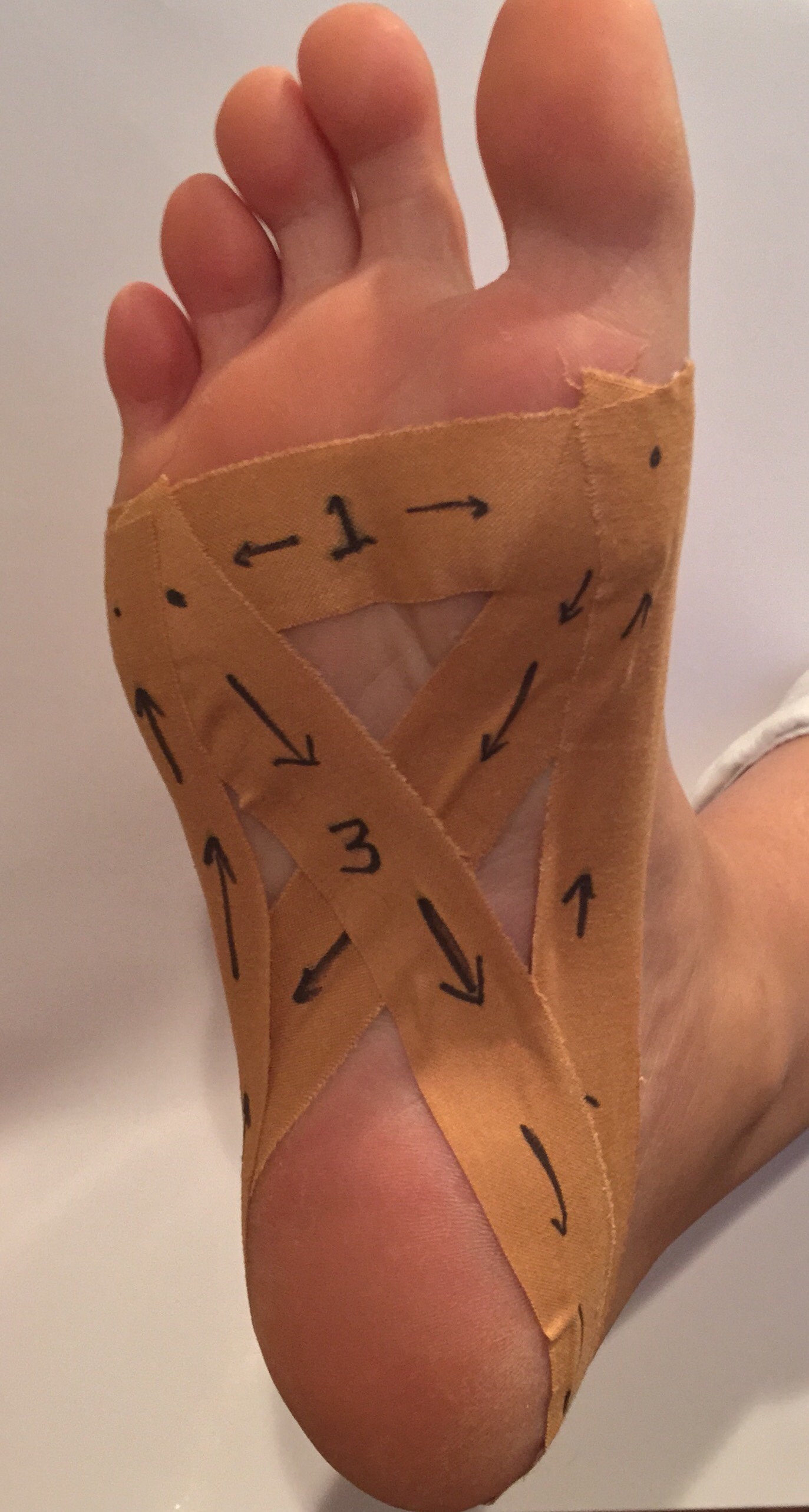

Make sure to put even pressure on these strips so that you do not bunch up the skin. Next, place the two short strips in front of the first short strip overlapping each other by 50%.Take the first short strip and place it on the front of the heel dividing the heel in half.Apply the next long strip on either side of the first strip overlapping by 50%.Make sure your foot is dry and apply the first long strip in the center of the foot starting just behind the ball of the foot and ending behind the heel.Cut three short strips of tape that are long enough to cover the foot side to side.Cut three long strips of tape starting from just behind the ball of the foot ending behind the heel.The taping can stay in place for up to 3-4 days. Make sure that you do not have an allergy to adhesive before you apply tape or adhesive spray to your skin. Also, you can use an adhesive spray to make the tape stick to your skin. We recommend that you use good high-quality tape like the Hypafix tape seen in the video. Huff taping a patient’s foot for heel pain and plantar fasciitis. Taping of the foot to support the plantar fascia can be beneficial and cause significant pain relief. It tends to feel better with activity but worsens again after you spend a long time on your feet. Usually, the pain is worse when you take your first steps in the morning or after you’ve been sitting for a long time. Inflammation and swelling can lead to tenderness throughout the underside of the foot. When this tissue becomes inflamed, it causes pain in your heel.

Plantar fasciitis is inflammation of the thick band of tissue (called fascia) at the bottom of your foot that runs from your heel to your toes. One of the most common reasons people experience heel pain in the morning is because of plantar fasciitis. But when you step down from your bed first thing in the morning and feel excruciating pain in your heel, it feels like there is little you can do.

Treatment for heel pain may include stretching, resting, icing, weight loss, anti-inflammatory medication, recommendations for shoes, and an orthotic. Almost 1 million patients visit a doctor for heel pain every year. 1, pp.Heel pain is one of the most common problems of the lower extremity. Journal: Journal of Back and Musculoskeletal Rehabilitation, vol. Keywords: Conservative treatment, efficacy, plantar fasciitis, review, taping More research is needed to investigate long-term effect and effectiveness of specific taping techniques. The best evidence exists for low dye taping and calcaneal taping. CONCLUSION:We found that in the short-term, taping is beneficial in treating plantar fasciitis. The most common technique was low dye taping. All eight studies favored the use of different taping techniques. Two studies were high quality two were moderate quality and four were of poor methodological quality. RESULTS:Five randomized control trials, one cross-over study and two single group repeated measures studies met the inclusion criteria. The methodological quality of interventional studies was evaluated inter alia by the PEDro score. Controlled trials of any methodological quality were included, without any language restrictions.

METHODS:PubMed, CINAHL, PEDro, ISI Web of Science, and Google Scholar databases were searched from inception until December 2012, using a predefined search strategy. OBJECTIVE:To evaluate, based on existing litera ture, the efficacy of different taping techniques in relieving symptoms and dysfunction caused by plantar fasciitis. Taping is one of the most widespread treatments, with several techniques utilized in clinical practice. Numerous non-surgical treatments have been used to relieve symptoms. Tel.: +972 52 2787050 Fax: +972 8 6477683 E-mail: Ībstract: BACKGROUND:Plantar fasciitis is considered the most common cause of foot pain. Authors: Podolsky, Roman | Kalichman, Leonid *Īffiliations: Department of Physical Therapy, Recanati School for Community Health Professions, Faculty of Health Sciences, Ben-Gurion University of the Negev, Beer Sheva, IsraelĬorresponding author: Leonid Kalichman, Department of Physical Therapy, Recanati School for Community Health Professions, Faculty of Health Sciences, Ben-Gurion University of the Negev, POB 653, Beer Sheva 84105, Israel.


 0 kommentar(er)
0 kommentar(er)
